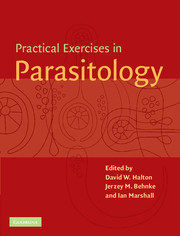Book contents
- Frontmatter
- Contents
- List of contributors
- Preface
- General advice
- 1 Observational Exercises on Parasites
- 2 Ecology
- 3 Physiology and Biochemistry
- 4 Pathology and Immunology
- 5 Chemotherapy
- 6 Molecular Parasitology
- 6.1 Purification of DNA
- 6.2 DNA digestion and gel electrophoresis
- 6.3 Restriction enzyme mapping
- 6.4 Construction of a genomic library
- 6.5 Detection and differentiation of Entamoeba histolytica and E. dispar by PCR
- 6.6 Differentiation between parasite species by agglutination and detection of parasite surface carbohydrates, using non-conjugated lectins
- 6.7 Tentative identification of parasite and tissue surface carbohydrates by conjugated lectins
- 7 Behaviour
- Appendix 1 Reagent index
- Appendix 2 UK suppliers
- Appendix 3 US suppliers
- Index
6.1 - Purification of DNA
Published online by Cambridge University Press: 05 June 2012
- Frontmatter
- Contents
- List of contributors
- Preface
- General advice
- 1 Observational Exercises on Parasites
- 2 Ecology
- 3 Physiology and Biochemistry
- 4 Pathology and Immunology
- 5 Chemotherapy
- 6 Molecular Parasitology
- 6.1 Purification of DNA
- 6.2 DNA digestion and gel electrophoresis
- 6.3 Restriction enzyme mapping
- 6.4 Construction of a genomic library
- 6.5 Detection and differentiation of Entamoeba histolytica and E. dispar by PCR
- 6.6 Differentiation between parasite species by agglutination and detection of parasite surface carbohydrates, using non-conjugated lectins
- 6.7 Tentative identification of parasite and tissue surface carbohydrates by conjugated lectins
- 7 Behaviour
- Appendix 1 Reagent index
- Appendix 2 UK suppliers
- Appendix 3 US suppliers
- Index
Summary
Aims and objectives
This exercise is designed to demonstrate the isolation of genomic DNA; it can, in principle, be adapted for use with any organism, including parasites. Specifically, the objectives are:
To perform bacterial cell lysis.
To extract the cell lysate with phenol/chloroform.
To isolate the DNA by ethanol precipitation.
Introduction
DNA encodes genetic information for all known living organisms. A basic method in molecular biology is the isolation of DNA. The version given here is for the preparation of DNA from Escherichia coli. In this context the practical is useful for demonstrating some basic methods in molecular biology as well as introducing students to the use of bacteria as hosts for gene cloning. This is a prerequisite for more complex molecular biological methods including the isolation of parasite genes and analysis of their expression products.
Laboratory equipment and consumables
(per student or group)
Equipment
Safety glasses
P20, P200, P1000 Gilson pipetmen or equivalents
Waste beaker for chemically contaminated plasticware
Autoclavable waste bags for bacterially contaminated waste
Waste container for bacterial culture supernatant
Bench top centrifuge capable of producing 1000 g
Water bath (37 °C) with suitable racks for Universal tubes
Centrifuge capable of producing 8000g at 10 °C
Use of cold room/refrigerator and freezer
Consumables
Latex gloves in a range of sizes
Sterile tips for pipetmen
Universal tube containing a 25 ml culture of E.coli grown overnight at 37 °C in L-broth
3 ml of bacterial cell lysis buffer
300 μ1 of 10% (w/v) sodium dodecyl sulphate (SDS) in a microfuge tube
- Type
- Chapter
- Information
- Practical Exercises in Parasitology , pp. 335 - 342Publisher: Cambridge University PressPrint publication year: 2001



